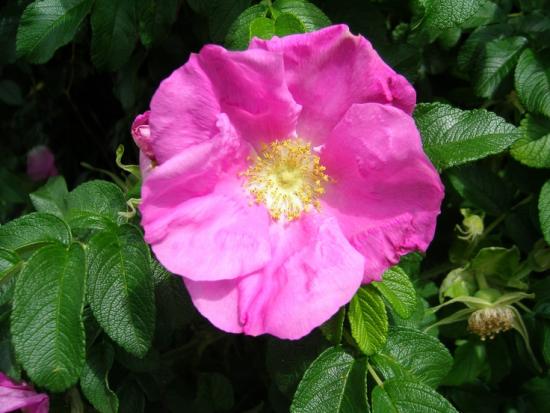How to distinguish a rose from a rose hip by its shoots?

Rose And rose hip belong to the same family - Rosaceae and have much in common. Their species are very closely intertwined, and some types of rose hips are considered wild roses and vice versa. But still, these plants differ from each other.
Content:
- Exploring the differences
- 4 differences between rose and rose hip shoots
- More about rose hips
- A little about roses
Exploring the differences
During the flowering of plants, answer the question: “How to distinguish a rose from a rose hip?” costs nothing, the difference is obvious. Just look at the flowers: roses have many petals, but rose hips have only five. In addition, rose hips bear fruit, which cannot be said about roses. Therefore, at the end of summer, the difference between a rose and a rose hip is obvious; the latter plant is distinguished by red or orange bright berries.

But what if, when planting, it becomes necessary to distinguish shoots of roses and rosehips? Let's name a few signs that make it clear how to distinguish a rose from a rose hip by its shoots.
4 differences between rose and rose hip shoots
- A rose produces red shoots, which then turn green; rose hips have young shoots that are immediately green.
- A rose has 3 - 5 leaves on a branch, a rose hip has 7, the top one does not have a pair.
- The color of rose leaves is dark green, the leaves are hard, large and glossy, rose hips have small, light green, matte leaves.
- Rose thorns are sparse and large, rose hips are frequent and small. Sometimes sepals and even rosehip leaves are covered with thorns.
If cultural roses grafted onto rose hips, then savage shoots often emerge from the roots.This situation is unpleasant because the rosehip takes over all the nutrition and weakens the crop. After all, its growth power is an order of magnitude higher. In this case, the layer of soil under the bush is raked to the depth of shoot regrowth, and the rosehip is cut flush with the root. Otherwise, when cut, it will begin to branch and produce many shoots instead of one.
More about rose hips
In temperate and cold zones, wild roses, which we call wild roses, usually bloom for a short time - in May-June. And subtropical evergreen wildflowers bloom almost continuously. Our species produce fruits in August-September. They are very meaty and juicy. Inside the rose hips there are bristly fibers that seem to wrap the hard fruit-nuts.

Rose hips in free growth most often grow in large bushes, up to 2 m in height. The branches are erect, slightly drooping. There are creeping species, the branches of which can cling to the trunks of trees and neighboring plants. So their shoots rise quite high.
There are bushes in the shape of pillows, then the growth of their bushes is low and dense. During flowering they are very decorative. The flowers are distinguished by numerous stamens and pistils; the petals can be white, yellow, pink, red and crimson.
Cultivated rose hips According to international botanical terminology, they are called park roses. They are actively used in landscaping; they have a very successful landscape appearance, close to nature. One of the elegant rose hips is the wrinkled rose, or rugosa rose (Rosa rugosa), and the hybrids created on its basis (Hybrid Rugosa).
It can be recognized by its wrinkled leaves and awl-shaped, dense, straight bristles and spines along the shoots. Its smell is pleasant, fragrant, but weakly expressed. The flowers are non-double and bloom throughout the summer.The bushes are very durable and unpretentious. They are good in borders and hedges and can be planted singly or in groups. The main advantage for our latitudes is frost resistance in winter. In winter they can be left without any shelter.
A little about roses
Observing roses, which are popular everywhere, you may not notice that much has changed in recent years, and the accumulated changes are already beginning to be actively put in order and classified. Patio roses and groundcovers are separated into special groups. Climbing miniatures appeared with unusual small flowers and tiny leaves.

About new varieties Many articles have been written, we will tell you a little about the shapes of flowers. According to the shape of the flowers, roses are divided into 9 main types:
- With a cone-shaped center - buds of a classic shape, characteristic of hybrid tea varieties, in which the petals are curled into a cone.
- Peony-shaped or spherical shape - numerous petals are concave inward, covering the center of the flower.
- A form with a loose center - loosely closed petals form a core of indefinite outline.
- Collapsed form - at the end of flowering, a flower of an initially regular shape loosens, the petals seem to fall out, exposing the stamens.
- Cup-shaped - numerous rose petals form a cup, the center of the flower is not covered.
- Square shape - the inner petals create, as it were, four sectors located radially outward of the flower.
- Pompom shape - numerous short petals form a round, almost spherical outline of the flower.
- Flat shape - a flower with numerous petals, slightly concave towards the middle of the flower.
- Rosette-shaped - the whole flower flows down to the middle, there is a concavity, but its shape itself is flat with numerous short petals.
Studying the differences between rose hips and roses, four main differences in shoots were identified. A brief description of rose hips is given, and their decorative qualities for the garden are given. The description of varietal roses shows their modern classification based on differences in flower shape. Roses and rose hips are very interesting crops for homestead farming; it is always a pleasure to watch their growth and flowering.












Comments
I have several rose bushes that produce shoots like rose hips, and I always prune them. The rose is grafted onto a rose hip and then it is more resistant to pests and frost.
Great article. Thanks to the author for the useful information! Although I had such a situation that the shoots of the rose were green right away.
I do not agree with the author of the article. Nowadays there are many varieties of roses that have both 5 and 7 leaves. The main indicator of a rosehip shoot is the light green shoot below the graft. The thorns on roses can also be different.
Tell me, otherwise I still don’t understand: - Can a rose bush grow into a rose hip? The fact is that I had a rose bush growing, although I don’t know what variety, and after four years the buds became much smaller, and instead of them rose hips began to appear...
Can a rose be reborn as a rose hip? Easily! Bushes grafted onto rose hips produce a lot of shoots - spruce grouse, which do not freeze out and if you do not take care of the bush, then degeneration is inevitable.
And it seemed to me that by the flowers and thorns on the stem it was easy to recognize which was a rose and which was a rosehip. And if the fruits have appeared, then, of course, there can be no doubt, this is a real rosehip.